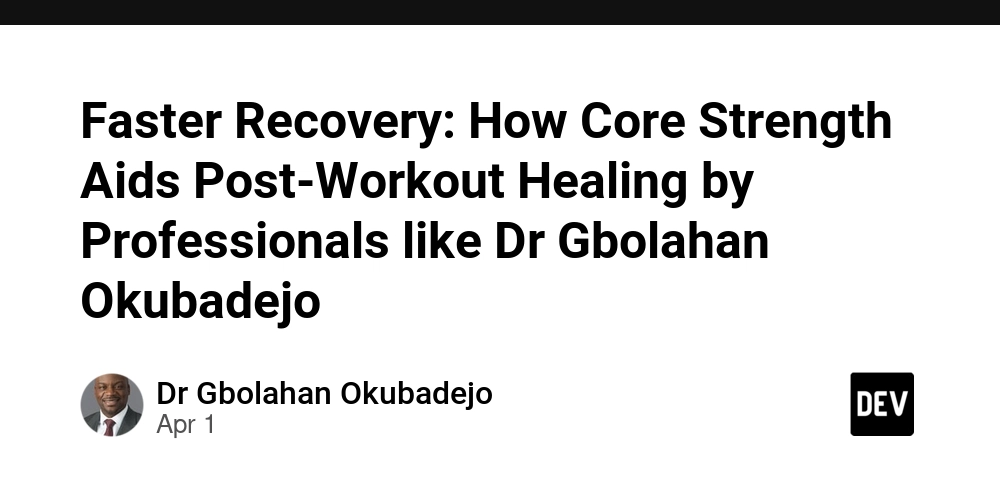Faster Recovery: How Core Strength Aids Post-Workout Healing by Professionals like Dr Gbolahan Okubadejo
When it comes to effective post-workout recovery, most people focus on hydration, stretching, or rest. However, a strong core can play an equally crucial role in speeding up recovery and ensuring better healing after intense physical activity. Core strength doesn’t just improve your athletic performance, but it also helps your body recover faster by supporting stability, reducing muscle strain, and preventing injuries. Strengthening your core can make a significant difference in your recovery routine, allowing you to perform at your best and reduce downtime between workouts. This blog will explore how core strength aids in post-workout healing and why it should be a priority in your fitness regimen. Core Muscles: The Foundation of Stability Your core muscles, as described by surgeons such as Dr Gbolahan Okubadejo, are the foundation of your entire body, acting as a support system for your spine, pelvis, and lower back. The core consists of a complex group of muscles, including the abdominals, obliques, lower back muscles, and the hip flexors. These muscles work together to stabilize your body during movement, ensuring that energy is transferred efficiently from your lower body to your upper body. When these muscles are strong, your body is better able to handle physical stress, allowing for quicker recovery after intense exercise. When you perform exercises, your core helps absorb the shock and stabilize the body, reducing the strain placed on other muscle groups. This stabilization not only improves your performance during the workout but also aids in post-workout healing by preventing unnecessary strain and injury. A weak core, on the other hand, can lead to poor posture, imbalance, and increased risk of injury, delaying recovery and potentially causing long-term damage. By strengthening your core, you enhance your body’s ability to recover and adapt after exercise. Reducing Muscle Fatigue and Soreness Spine specialists including Dr Gbolahan Okubadejo explain that core strength plays a crucial role in minimizing muscle fatigue and soreness following a workout. After intense physical activity, muscle fibers experience micro-tears that need time to repair, resulting in delayed onset muscle soreness (DOMS). A strong core helps to distribute the workload more evenly across your body during exercise, preventing certain muscle groups from being overburdened. This balance leads to less localized muscle fatigue and soreness after a workout. Furthermore, a stronger core improves posture and alignment, reducing the strain on your muscles and joints. Poor posture, often a result of weak core muscles, can lead to increased tension in certain areas of the body, contributing to discomfort and delayed recovery. By ensuring that your core muscles are strong, you can avoid misalignments that may exacerbate post-workout pain. The reduced strain helps your muscles recover faster, allowing you to get back to your next workout with less pain and more energy. Enhancing Blood Flow and Nutrient Delivery Professionals such as Dr Gbolahan Okubadejo stress that proper blood circulation is essential for muscle recovery, as it helps to deliver oxygen and nutrients to muscles while removing waste products like lactic acid. A strong core improves posture and body alignment, which in turn encourages better circulation throughout your body. When your body is aligned and stable, blood flows more efficiently to the muscles that need it most, speeding up the healing process after a workout. In addition, many core-strengthening exercises, such as planks or bridges, engage large muscle groups, which can stimulate greater blood flow to the entire body. The increased circulation brought about by these exercises promotes faster nutrient delivery and waste removal, accelerating muscle recovery. A well-functioning circulatory system ensures that your body heals more efficiently, reducing soreness and stiffness that can accompany post-workout recovery. Preventing Injuries and Supporting Joint Health Core strength is a key factor in preventing injuries, particularly in the lower back and joints. Many sports and fitness activities place significant stress on the body’s joints and muscles, and a weak core can lead to instability, increasing the risk of strains and sprains. Surgeons including Dr Gbolahan Okubadejo underline that a strong core acts as a stabilizer, protecting the spine and other major joints from unnecessary stress during physical activity. By improving the stability and support provided by your core muscles, you reduce the risk of injury during both workouts and everyday activities. Additionally, strengthening your core helps protect the lower back, a common area for injury, by maintaining proper posture and alignment. Injury prevention is essential for quick recovery; if you avoid injury in the first place, your body will be able to heal faster, allowing you to return to physical activity sooner. Boosting Flexibility and

When it comes to effective post-workout recovery, most people focus on hydration, stretching, or rest. However, a strong core can play an equally crucial role in speeding up recovery and ensuring better healing after intense physical activity. Core strength doesn’t just improve your athletic performance, but it also helps your body recover faster by supporting stability, reducing muscle strain, and preventing injuries. Strengthening your core can make a significant difference in your recovery routine, allowing you to perform at your best and reduce downtime between workouts. This blog will explore how core strength aids in post-workout healing and why it should be a priority in your fitness regimen.
Core Muscles: The Foundation of Stability
Your core muscles, as described by surgeons such as Dr Gbolahan Okubadejo, are the foundation of your entire body, acting as a support system for your spine, pelvis, and lower back. The core consists of a complex group of muscles, including the abdominals, obliques, lower back muscles, and the hip flexors. These muscles work together to stabilize your body during movement, ensuring that energy is transferred efficiently from your lower body to your upper body. When these muscles are strong, your body is better able to handle physical stress, allowing for quicker recovery after intense exercise.
When you perform exercises, your core helps absorb the shock and stabilize the body, reducing the strain placed on other muscle groups. This stabilization not only improves your performance during the workout but also aids in post-workout healing by preventing unnecessary strain and injury. A weak core, on the other hand, can lead to poor posture, imbalance, and increased risk of injury, delaying recovery and potentially causing long-term damage. By strengthening your core, you enhance your body’s ability to recover and adapt after exercise.
Reducing Muscle Fatigue and Soreness
Spine specialists including Dr Gbolahan Okubadejo explain that core strength plays a crucial role in minimizing muscle fatigue and soreness following a workout. After intense physical activity, muscle fibers experience micro-tears that need time to repair, resulting in delayed onset muscle soreness (DOMS). A strong core helps to distribute the workload more evenly across your body during exercise, preventing certain muscle groups from being overburdened. This balance leads to less localized muscle fatigue and soreness after a workout.
Furthermore, a stronger core improves posture and alignment, reducing the strain on your muscles and joints. Poor posture, often a result of weak core muscles, can lead to increased tension in certain areas of the body, contributing to discomfort and delayed recovery. By ensuring that your core muscles are strong, you can avoid misalignments that may exacerbate post-workout pain. The reduced strain helps your muscles recover faster, allowing you to get back to your next workout with less pain and more energy.
Enhancing Blood Flow and Nutrient Delivery
Professionals such as Dr Gbolahan Okubadejo stress that proper blood circulation is essential for muscle recovery, as it helps to deliver oxygen and nutrients to muscles while removing waste products like lactic acid. A strong core improves posture and body alignment, which in turn encourages better circulation throughout your body. When your body is aligned and stable, blood flows more efficiently to the muscles that need it most, speeding up the healing process after a workout.
In addition, many core-strengthening exercises, such as planks or bridges, engage large muscle groups, which can stimulate greater blood flow to the entire body. The increased circulation brought about by these exercises promotes faster nutrient delivery and waste removal, accelerating muscle recovery. A well-functioning circulatory system ensures that your body heals more efficiently, reducing soreness and stiffness that can accompany post-workout recovery.
Preventing Injuries and Supporting Joint Health
Core strength is a key factor in preventing injuries, particularly in the lower back and joints. Many sports and fitness activities place significant stress on the body’s joints and muscles, and a weak core can lead to instability, increasing the risk of strains and sprains. Surgeons including Dr Gbolahan Okubadejo underline that a strong core acts as a stabilizer, protecting the spine and other major joints from unnecessary stress during physical activity.
By improving the stability and support provided by your core muscles, you reduce the risk of injury during both workouts and everyday activities. Additionally, strengthening your core helps protect the lower back, a common area for injury, by maintaining proper posture and alignment. Injury prevention is essential for quick recovery; if you avoid injury in the first place, your body will be able to heal faster, allowing you to return to physical activity sooner.
Boosting Flexibility and Range of Motion
While strength is important, flexibility is also a key component of post-workout recovery. A strong core is directly linked to improved flexibility and a greater range of motion. Spine specialists like Dr Gbolahan Okubadejo note that many core exercises, such as yoga poses and Pilates movements, incorporate stretching, which helps lengthen the muscles and improve flexibility. This increased flexibility allows your muscles to recover more effectively by reducing stiffness and enhancing mobility.
In addition, flexibility in the core muscles helps with overall body movement, making it easier to perform other exercises and stretches. As your core becomes more flexible, it supports more fluid movements, reducing the risk of injury while also speeding up recovery time. A well-balanced combination of strength and flexibility allows your body to heal faster and get back to peak performance more quickly.
Supporting Mental Recovery
Physical recovery is important, but mental recovery is just as essential after an intense workout. Core strengthening exercises, particularly those that involve balance and stability, also promote mindfulness and focus. This mental aspect of core training can help you reconnect with your body and reduce stress, which is crucial for the healing process.
Strengthening your core muscles is a powerful tool for improving post-workout recovery. By enhancing stability, reducing fatigue, improving circulation, preventing injuries, and promoting flexibility, a strong core supports faster healing and reduces the time it takes to return to peak performance. Moreover, the mental benefits of core training provide added motivation to stay committed to your fitness goals. Incorporating core-strengthening exercises into your routine not only helps you recover faster but also improves your overall health, performance, and well-being.











































































































































































![[The AI Show Episode 142]: ChatGPT’s New Image Generator, Studio Ghibli Craze and Backlash, Gemini 2.5, OpenAI Academy, 4o Updates, Vibe Marketing & xAI Acquires X](https://www.marketingaiinstitute.com/hubfs/ep%20142%20cover.png)




























































































































![[DEALS] The Premium Learn to Code Certification Bundle (97% off) & Other Deals Up To 98% Off – Offers End Soon!](https://www.javacodegeeks.com/wp-content/uploads/2012/12/jcg-logo.jpg)


![From drop-out to software architect with Jason Lengstorf [Podcast #167]](https://cdn.hashnode.com/res/hashnode/image/upload/v1743796461357/f3d19cd7-e6f5-4d7c-8bfc-eb974bc8da68.png?#)








































































































.png?#)

































_Christophe_Coat_Alamy.jpg?#)
 (1).webp?#)





































































































![Apple Considers Delaying Smart Home Hub Until 2026 [Gurman]](https://www.iclarified.com/images/news/96946/96946/96946-640.jpg)
![iPhone 17 Pro Won't Feature Two-Toned Back [Gurman]](https://www.iclarified.com/images/news/96944/96944/96944-640.jpg)
![Tariffs Threaten Apple's $999 iPhone Price Point in the U.S. [Gurman]](https://www.iclarified.com/images/news/96943/96943/96943-640.jpg)




































































































































